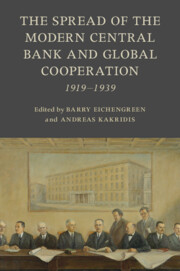37 results
13 - The MPC
- from V - Lessons for Central Bank Independence
-
-
- Book:
- Reflections on Monetary Policy after 25 Years of the MPC
- Published online:
- 14 November 2024
- Print publication:
- 21 November 2024, pp 161-168
-
- Chapter
- Export citation
11 - An Analysis of Central Bank Decision-Making
- from IV - MPC Process
-
-
- Book:
- Reflections on Monetary Policy after 25 Years of the MPC
- Published online:
- 14 November 2024
- Print publication:
- 21 November 2024, pp 131-144
-
- Chapter
- Export citation
2 - Twenty-Five Years of Bank of England Independence
- from I - Overview
-
-
- Book:
- Reflections on Monetary Policy after 25 Years of the MPC
- Published online:
- 14 November 2024
- Print publication:
- 21 November 2024, pp 10-22
-
- Chapter
- Export citation
1 - An Introduction
- from I - Overview
-
-
- Book:
- Reflections on Monetary Policy after 25 Years of the MPC
- Published online:
- 14 November 2024
- Print publication:
- 21 November 2024, pp 3-9
-
- Chapter
- Export citation
6 - The MPC Remit at 25: Growing Pains?
- from III - Targets and Instruments
-
-
- Book:
- Reflections on Monetary Policy after 25 Years of the MPC
- Published online:
- 14 November 2024
- Print publication:
- 21 November 2024, pp 79-88
-
- Chapter
- Export citation
3 - Reliable Partners
- from II - Communication
-
-
- Book:
- Reflections on Monetary Policy after 25 Years of the MPC
- Published online:
- 14 November 2024
- Print publication:
- 21 November 2024, pp 25-48
-
- Chapter
- Export citation
14 - Outlines of a Reform Programme for the UK’s Monetary Regime
- from V - Lessons for Central Bank Independence
-
-
- Book:
- Reflections on Monetary Policy after 25 Years of the MPC
- Published online:
- 14 November 2024
- Print publication:
- 21 November 2024, pp 169-186
-
- Chapter
- Export citation

Reconsidering Central Bank Independence
-
- Published online:
- 25 April 2024
- Print publication:
- 02 May 2024
4 - The Monetary Policy of the European Central Bank
-
- Book:
- The Individual in the Economic and Monetary Union
- Published online:
- 04 January 2024
- Print publication:
- 25 January 2024, pp 107-137
-
- Chapter
-
- You have access
- Open access
- HTML
- Export citation
Conclusion
-
- Book:
- The Individual in the Economic and Monetary Union
- Published online:
- 04 January 2024
- Print publication:
- 25 January 2024, pp 171-182
-
- Chapter
-
- You have access
- Open access
- HTML
- Export citation
1 - Interwar Central Banks
- from Part I - General
-
-
- Book:
- The Spread of the Modern Central Bank and Global Cooperation
- Published online:
- 02 November 2023
- Print publication:
- 16 November 2023, pp 3-39
-
- Chapter
- Export citation
10 - The Bulgarian National Bank, 1926–1935
- from Part II - Specific
-
-
- Book:
- The Spread of the Modern Central Bank and Global Cooperation
- Published online:
- 02 November 2023
- Print publication:
- 16 November 2023, pp 268-300
-
- Chapter
- Export citation

The Spread of the Modern Central Bank and Global Cooperation
- 1919–1939
-
- Published online:
- 02 November 2023
- Print publication:
- 16 November 2023
Inductive Risk and the Legitimacy of Non-Majoritarian Institutions
-
- Journal:
- British Journal of Political Science / Volume 54 / Issue 2 / April 2024
- Published online by Cambridge University Press:
- 06 July 2023, pp. 389-404
-
- Article
-
- You have access
- Open access
- HTML
- Export citation
Central bank independence: A social economic and democratic critique
-
- Journal:
- The Economic and Labour Relations Review / Volume 24 / Issue 1 / March 2013
- Published online by Cambridge University Press:
- 01 January 2023, pp. 32-50
-
- Article
- Export citation
7 - Selective Government Bond Purchases
- from Part II - Crises, ECB Measures and the Macroeconomic Constitution
-
- Book:
- The European Central Bank and the European Macroeconomic Constitution
- Published online:
- 15 September 2022
- Print publication:
- 22 September 2022, pp 162-192
-
- Chapter
- Export citation
4 - The Organisation and Functions of the Bank of Korea
- from Part III - How Is Monetary Policy Conducted in Korea?
-
- Book:
- Monetary Policy and Central Banking in Korea
- Published online:
- 17 February 2022
- Print publication:
- 24 February 2022, pp 81-113
-
- Chapter
- Export citation
9 - The Prospects of RMB Internationalization
-
- Book:
- One Currency, Two Markets
- Published online:
- 17 June 2021
- Print publication:
- 08 July 2021, pp 269-286
-
- Chapter
- Export citation
3 - Committing to Stability
- from Part II - The Original Stability Conception
-
- Book:
- The Currency of Solidarity
- Published online:
- 24 September 2020
- Print publication:
- 08 October 2020, pp 81-153
-
- Chapter
- Export citation
1 - Introductory
-
- Book:
- Making a Modern Central Bank
- Published online:
- 18 September 2020
- Print publication:
- 17 September 2020, pp 1-31
-
- Chapter
- Export citation

